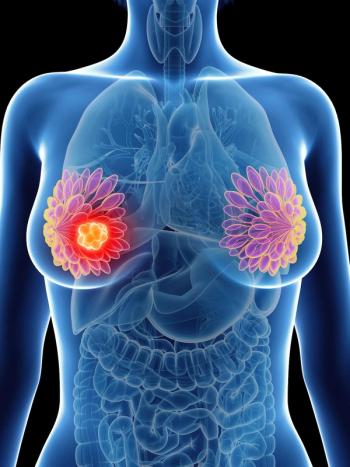
- ONCOLOGY Vol 9 No 6
- Volume 9
- Issue 6
MRI May Reduce the Number of Biopsies for Breast Cancer
Like a colorblind coach who can see all the players but cannot tell who is friendly, x-ray mammography is effective in finding suspicious breast lesions but is not reliable in determining which ones are cancerous. Because of this uncertainty, about
Like a colorblind coach who can see all the players but cannottell who is friendly, x-ray mammography is effective in findingsuspicious breast lesions but is not reliable in determining whichones are cancerous. Because of this uncertainty, about 500,000women have their breast lesions examined by surgical biopsy eachyear, even though most biopsies show the tissue to be benign.
Research carried out at the University of Wisconsin Medical Schoolin Madison suggests that MRI can clear up many questions leftunanswered by conventional imaging systems, and may significantlyreduce the number of surgical breast biopsies.
A recent study led by diagnostic radiologist Dr. Frederick Kelczused special MRI techniques to classify 72 breast lesions in 70women at the University of Wisconsin Hospital and Clinics. Bycomparing MRI-based predictions with biopsy results, Kelcz' teamwas able to correctly predict 50 of 55 benign lesions and 14 of17 malignant lesions. Kelcz presented findings from the 3-yearstudy at a recent Radiological Society of North America meeting.
"In our study, MRI could have reduced the unnecessary biopsyrate by 90%," Dr. Kelcz said. "Even though MRI is expensive,surgical biopsy is several times more costly. Ultimately, MRImay prove cost-effective for determining which women really needbiopsy."
Women in the study were examined with dynamic, enhanced MRI whena mammogram or breast examination suggested a problem requiringbiopsy. The women were injected with a dye during a rapid seriesof MRI images. In general, the faster the magnetic dye was absorbedby a breast mass, the more likely it was that the mass was malignant.In the current study, about one-third of breast abnormalitiesdid not take up the dye, and all of these were benign, Dr. Kelczsaid.
The University of Wisconsin study is part of a worldwide effortto improve the technology used in diagnosing and managing cancerand other breast problems. Mammography is the most cost-effectivemethod for the large-scale detection of breast abnormalities.But signs of malignancy can be subtle on x-ray film, where allbreast tissues overlap. This makes it difficult for doctors tofind or classify some abnormalities, said Dr. Kelcz, who is AssociateProfessor of Radiology at the University of Wisconsin MedicalSchool.
Magnetic resonance imaging, which produces cross-sectional picturesof soft tissue, has rapidly become the primary imaging methodfor diagnosing brain and spinal cord abnormalities and checkingbreast implants for leakage. "MRI won't replace mammographyor biopsy, but it may become an important problem-solving toolfor breast cancer," Dr. Kelcz said. The study suggested severalsituations in which MRI might supplement a mammographic examination:
When a suspected cancerous lesion can be seen only on one mammographicview, as can happen with the dense glandular breast tissue commonin younger women and in older women on hormonal therapy
When deciding between lumpectomy or mastectomy (MRI may revealpreviously undetected lesions, suggesting an advantage to mastectomy.)
After lumpectomy to ensure that all malignant tissue has beenremoved and to distinguish scar tissue from recurrent tumor
When a mammogram shows multiple lesions in a woman with a strongfamily history of breast cancer.
Dr. Kelcz cautioned that MRI should not be used as a general substitutefor mammography or biopsy. "MRI alone would have misdiagnosedthree cancers detected by mammography, so we advise patients witha negative MRI to get at least two follow-up examinations at sixmonth intervals to make sure that the abnormality is not growing,"'he said. The Madison researchers are working to increase MRI'spredictive accuracy.
In addition, the study showed that it isn't cost-effective touse MRI when conventional imaging systems suggest a lesion witha high likelihood of being either benign or malignant, Dr. Kelczsaid. Magnetic resonance imaging also can be inaccurate in tryingto diagnose malignancy when mammography shows a small clusterof very tiny calcifications.
Dr. Kelcz' interest in breast MRI stemmed from his experiencein interpreting mammograms: "For other parts of the body,we have several methods to help us decide whether or not an abnormalityis cancer," he said. "In the breast, however, therewas little we could suggest aside from biopsy or follow-up mammography."
In the future, MRI could provide essential information to womenwho have a strong family history of breast cancer or who testpositive for the "breast cancer gene" but have negativemammograms, Dr. Kelcz speculated.
Articles in this issue
over 29 years ago
Measuring the Cost-Effectiveness of Cancer Careover 29 years ago
Measuring the Cost-Effectiveness of Cancer Careover 29 years ago
Measuring the Cost-Effectiveness of Cancer Careover 30 years ago
HIV Counseling and Testing-United States, 1993over 30 years ago
Book Review: Adjuvant Therapy of Cancer--VIIover 30 years ago
New Approach to Diagnosing High-Risk, Early-Stage Ovarian Cancerover 30 years ago
New Jersey Researchers Testing Unique Blood SubstituteNewsletter
Stay up to date on recent advances in the multidisciplinary approach to cancer.

















































































